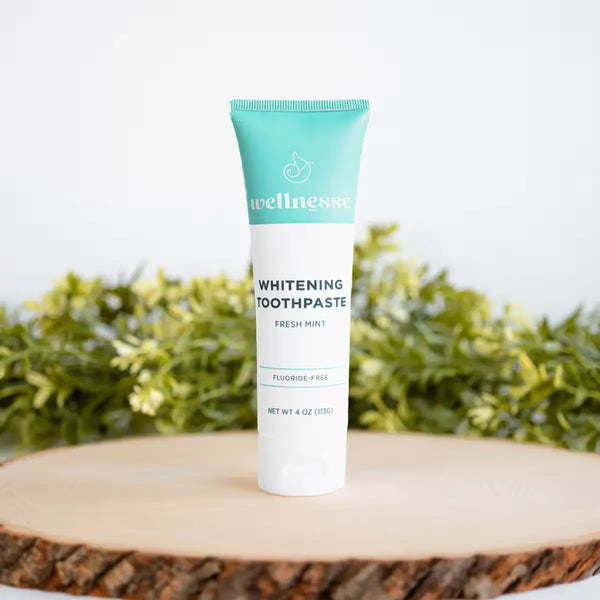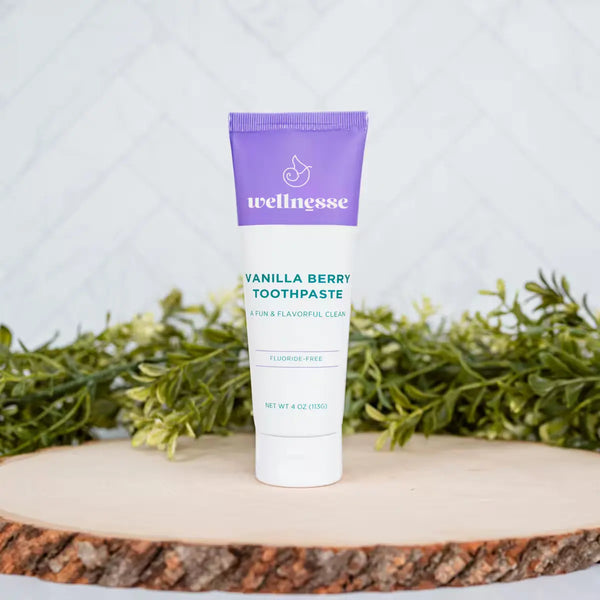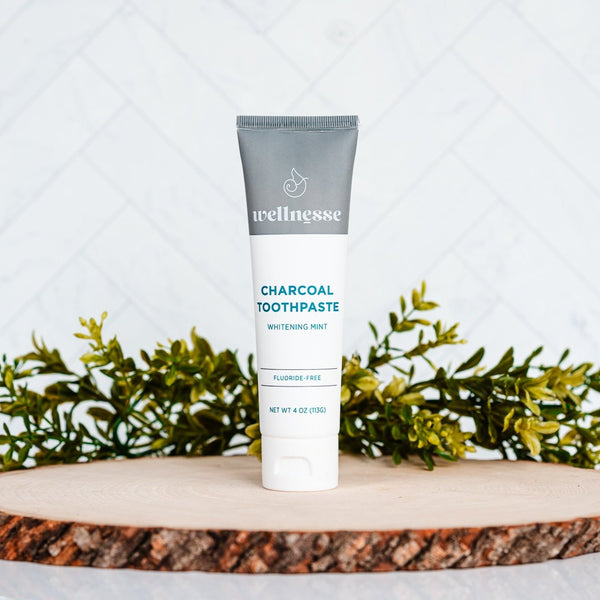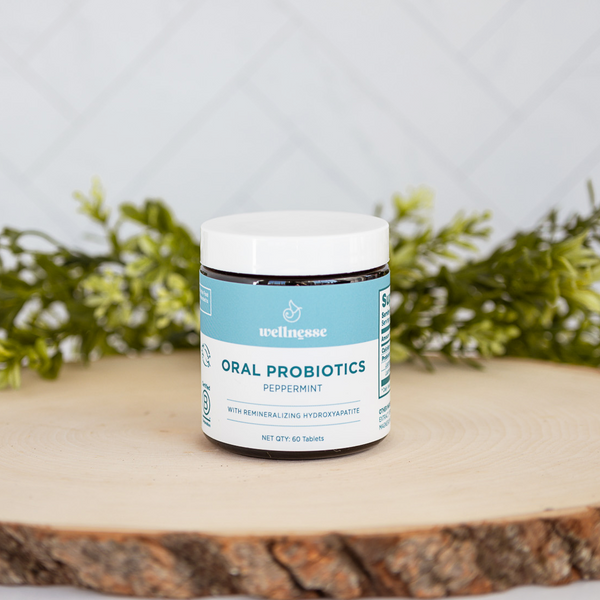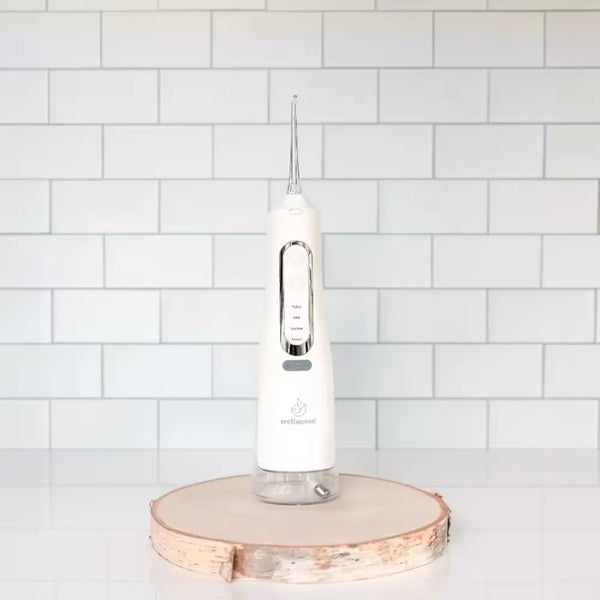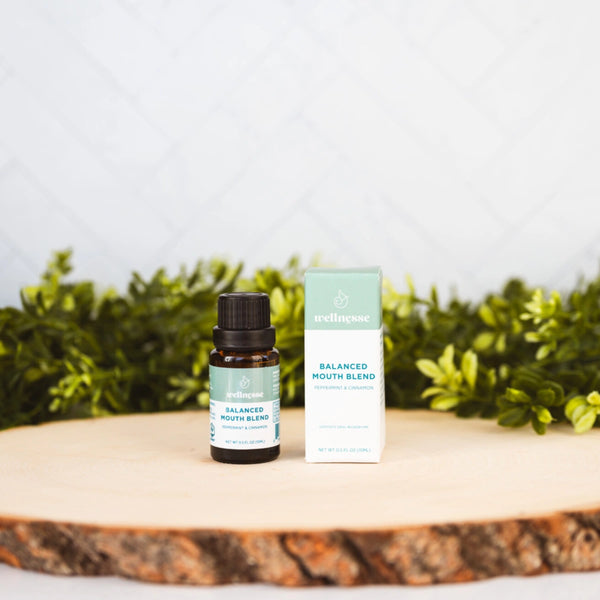We all want a brighter smile, but how you get there matters even more than the results.
Teeth whitening is now one of the most requested cosmetic dental treatments. Options range from drugstore whitening strips and trays to in-office bleaching. While these treatments can make teeth appear whiter, there are some very real risks. Beneath the promise of a pearly smile lies a story of enamel erosion, oral microbiome disruption, and potential long-term sensitivity.
At Wellnesse, we believe in an approach to oral care that protects the integrity of your teeth while promoting overall health. Teeth are living structures, not just static white surfaces. What we put on them and into our mouths affects not just appearance, but also long-term wellness. Before reaching for a conventional whitening kit, it’s worth understanding how these products work and what risks they carry. There are safer natural alternatives that can help achieve the same goal, without the downsides.
What Are Teeth Whiteners and How Do They Work?
Most whitening products rely on chemicals like hydrogen peroxide or carbamide peroxide. These substances release highly reactive free radicals that break down larger, pigmented molecules (called chromophores) from coffee, red wine, or tea. By oxidizing these compounds, they scatter light differently and make the teeth appear lighter.
Dentist-supervised whitening procedures use higher concentrations, sometimes as much as 35% hydrogen peroxide. Compare this to over-the-counter options, which generally range between 3% and 10%. To speed up the process, dental offices will sometimes radiate the enamel to create even more free radicals. Yes, the same radiation and free radicals that are linked with cancer!
Other whitening formulas are sometimes marketed as gentler alternatives. However, studies show that even these can weaken enamel and alter teeth’s surface over time.
While whitening products can temporarily improve the appearance of teeth, the tradeoff is that the enamel itself becomes more porous and vulnerable. Our teeth aren’t just lifeless shells, but intricate biocomposites with a delicate balance of minerals, proteins, and living tissue.
Harsh Impacts on Mouth Health
Enamel is the hardest substance in the human body, but it’s also irreplaceable. Whitening agents penetrate beyond the surface stains to reach the underlying tooth structure. Along the way, they can cause microscopic damage to the enamel and impact the mineral ratio that keeps teeth strong. Studies show mineral loss reaching up to 250 microns below enamel’s surface after repeated whitening treatments.
Losing mineral density doesn’t just thin the enamel, it also exposes the dentin beneath, which has a naturally yellowish hue. Ironically, the very process of whitening can eventually make teeth appear darker by revealing more dentin as the enamel wears away. In severe cases, enamel erosion can make teeth look translucent at the edges.
The oral microbiome is another important piece of the puzzle. Hydrogen peroxide and similar agents have antibacterial properties. While this might sound like a good thing at first, using large amounts found in teeth whiteners disrupts the microbe balance in the mouth. Just like our gut, the oral microbiome supports the immune system, helps regulate pH, and plays a role in digestion. Repeated exposure to antibacterial whitening agents can tip this balance. The result is more dysbiosis, gum irritation, and increased risk of cavities.
Short-Term Side Effects of Whitening Treatments
One of the most common complaints after whitening is tooth sensitivity. Between 43% and 80% of patients experience this after peroxide-based treatments. This sensitivity is thought to result from tiny channels in the enamel becoming more open, allowing oxygen radicals to travel closer to the nerves. The result is inflammation of the dental pulp and a temporary increase in nerve sensitivity.
Other side effects include gum irritation, burns on the soft tissues of the mouth, and sensitivity or pain with hot, cold, or acidic foods. In-office whitening procedures, though more carefully monitored, still carry the same risks. Especially if the peroxide gel comes into direct contact with the gums.
Long-Term Effects and Potential Risks
While occasional whitening may not cause noticeable problems, doing it often or using really harsh treatments can have lasting consequences. Over-whitening, sometimes called “bleachorexia,” can thin enamel to the point where the underlying dentin becomes permanently visible. This creates the opposite of the desired effect. Teeth may look more yellow, brittle, or translucent over time.
Research shows that conventional whitening treatments can lead to:
-
Permanent enamel erosion because of mineral loss.
-
Chronic sensitivity due to nerve exposure.
-
Tooth structure changes, including weakening the collagen matrix in dentin.
-
Oral microbiome disruption, which plays a key role in both oral and overall health.
Lab studies show that even other chemical alternatives to peroxide can reduce enamel hardness and cause surface damage. This reinforces the idea that whitening chemicals in general aren’t harmless. They fundamentally change tooth surfaces in ways that may not be reversible.
Building Whiter Teeth Naturally
Whitening isn’t the only way to achieve a bright smile. Some of the healthiest and whitest teeth historically weren’t the result of chemical treatments but of strong enamel built from the inside out. Teeth are dynamic structures that respond to diet, mineral intake, and lifestyle choices. Supporting them naturally often produces better long-term results than chasing temporary whiteness through harsh chemicals.
The Role of Nutrient-Dense Foods
Minerals and fat-soluble vitamins play an essential role in building strong, naturally white enamel. Calcium, phosphorus, and magnesium form the backbone of enamel’s crystalline structure, while vitamins A, D, and K2 help regulate how those minerals are absorbed and deposited. Diets that are rich in pastured butter, grass-fed meats, wild-caught fish, organ meats, and mineral-rich vegetables all provide these foundational nutrients.
Modern processed foods, on the other hand, are devoid or low in these key nutrients. This leaves teeth weaker and more prone to staining, cavities, and enamel erosion. The healthier our diets, the more naturally white our teeth.
Weston A. Price and Traditional Diets
The pioneering dentist Weston A. Price traveled the world in the early 20th century to study traditional cultures and their dental health. He observed that communities eating nutrient-dense, traditional diets had broad dental arches, straight teeth, and no cavities. Their teeth were not only healthier, but they also tended to be naturally whiter and stronger. All without the interventions of modern dentistry.
Price’s work highlighted that tooth color and strength reflect overall nutrition and mineral status. When traditional foods were replaced by processed flours, sugars, and vegetable oils, cavities, crowding, and discoloration became common.
Lifestyle Habits for Whiter Teeth
Certain lifestyle choices can either preserve or dull your natural tooth color. Drinks like coffee, tea, soda, and wine are common culprits of staining. Interestingly, almost all wines sold in the U.S. contain added dyes to enhance their color, which further contributes to staining. If you do consume these drinks, it’s important to rinse your mouth well afterward to help minimize tooth staining and acid damage.
Smoking, poor oral hygiene, and frequent snacking on processed, sugary foods also create an environment where enamel breaks down and stains accumulate. While habits like staying hydrated, chewing crunchy vegetables, and brushing with a mineral-rich toothpaste all contribute to maintaining a brighter smile naturally.
Better Natural Whitening Options
If you’re looking for safer alternatives, there are options that support enamel health instead of compromising it.
-
Wellnesse Whitening Toothpaste: Formulated with hydroxyapatite, a mineral that naturally rebuilds enamel. Hydroxyapatite toothpaste whitens by strengthening the tooth surface rather than eroding it. There is a post-brushing whitening effect with hydroxyapatite as it adheres as a white particle to the enamel and also helps prevent plaque buildup. Studies and user feedback confirm the visible whitening benefits of Wellnesse Whitening Toothpaste.
-
Wellnesse Charcoal Toothpaste: This provides gentle whitening benefits while supporting detoxification and helps pull stains off of teeth. And because the charcoal is specifically formulated inside of a gentle toothpaste, it’s not as harsh or messy as pure charcoal.
-
Wellnesse Charcoal Toothbrush: Designed to reach hard-to-clean areas while remaining gentle on enamel. This charcoal toothbrush has bristles infused with charcoal to help absorb impurities and whiten naturally.
When combined with a nutrient-dense diet, mindful lifestyle habits, and the right oral care products, these tools can support a naturally brighter and healthier smile.
Final Thoughts on Teeth Whiteners
The quest for a whiter smile shouldn’t come at the cost of enamel health, oral microbiome balance, or long-term comfort. Conventional whitening treatments rely on harsh chemicals that strip away minerals, increase sensitivity, and disrupt the delicate ecosystem of the mouth. While they may deliver fast results, they also set the stage for long-term problems.
A better approach focuses on building strong, resilient teeth from the inside out with nutrient-dense foods, minerals, and gentle, natural oral care products. Whitening doesn’t have to mean weakening your teeth. It can mean supporting them in ways that highlight their natural strength and beauty. At Wellnesse, we’re committed to helping you achieve a bright smile the safe, sustainable way.
References:
-
Müller-Heupt, L. K., et al. (2023). Effectiveness and Safety of Over-the-Counter Tooth-Whitening Agents Compared to Hydrogen Peroxide In Vitro. International journal of molecular sciences, 24(3), 1956.
-
Novak, S. (2024, December 2 ). Too Much Teeth Whitening Can Cause Damage. Here’s What to Know. Scientific American.
-
Epple, M., Meyer, F., & Enax, J. (2019). A Critical Review of Modern Concepts for Teeth Whitening. Dentistry journal, 7(3), 79.
-
Weston A Price Foundation.(2000, January 1). Ancient Dietary Wisdom for Tomorrow’s Children.
-
Cubillos, N. (2024, March 18). Do Strawberries for Teeth Whitening Really Work? World of Dentistry.
-
Zoller, M. et al. (2023). Relative dentin and enamel abrasivity of charcoal toothpastes. International journal of dental hygiene, 21(1), 149–156.
-
Ghajari, M. et al. (2021). Abrasiveness and whitening effect of charcoal-containing whitening toothpastes in permanent teeth. Dental research journal, 18, 51.



